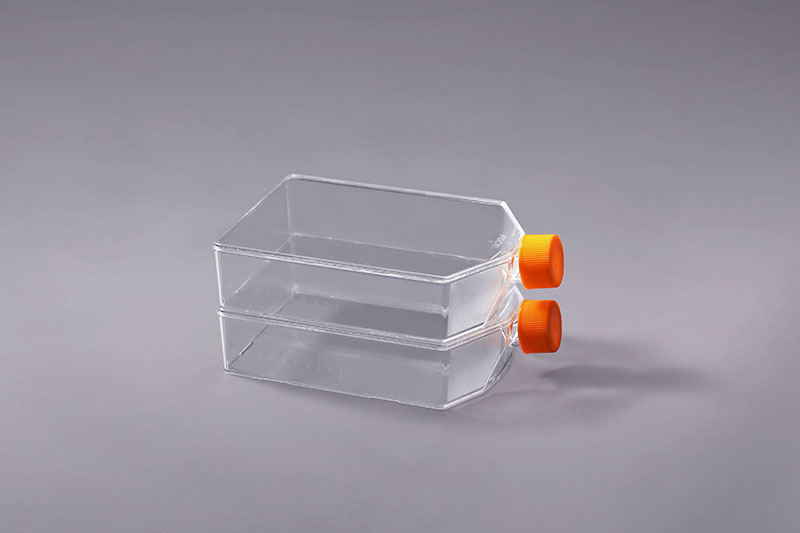เป็นวัสดุสิ้นเปลืองสำหรับการเพาะเลี้ยงเซลล์ประเภทขวด เพื่อส่งเสริมประสิทธิภาพการเกาะติดของเซลล์ วัสดุสิ้นเปลืองจะถูกเคลือบเมื่อเพาะเลี้ยงเซลล์ปฐมภูมิ บัฟเฟอร์เคลือบที่ใช้กันทั่วไป ได้แก่:Polylysine: เป็นสารประกอบสังเคราะห์ ซึ่งเป็นกรดอะมิโนที่มีประจุบวก ซึ่งส่งเสริมการยึดเกาะของเซลล์โดยการเปลี่ยนอิเล็กโทรดบนพื้นผิวของซับสเตรตการเพาะเลี้ยง มีการใช้กันอย่างแพร่หลายในการเพาะเลี้ยงเซลล์สำหรับการเคลือบเพื่อส่งเสริมการยึดเกาะของเซลล์ นอกเหนือจากการส่งเสริมการยึดเกาะและการเจริญเติบโตของเซลล์แล้ว การเคลือบโพลีไลซีนด้วยสารละลายเคลือบยังสามารถเพิ่มอัตราการรอดตายของเซลล์ปฐมภูมิและส่งเสริมการงอกของนิวไรท์ได้อีกด้วยcell culture flask
Fibronectin: เป็นไกลโคโปรตีนโมเลกุลสูงที่เริ่มทำการวิจัยและค้นพบในต่างประเทศในปี 1974 และมีหน้าที่ทางชีวภาพที่หลากหลาย Fibronectin เป็นไกลโคโปรตีนที่มีน้ำหนักโมเลกุล 440-500kDa พบในโปรตีนผิวเซลล์และพลาสมา โดยผสมผสานกับตัวรับผิวเยื่อหุ้มเซลล์และส่วนประกอบเมทริกซ์นอกเซลล์เพื่อส่งเสริมการยึดเกาะและการขยายตัวของเซลล์
เจลาติน: ส่วนผสมของโปรตีนที่ละลายน้ำได้น้ำหนักโมเลกุลสูงที่ได้มาจากคอลลาเจน สารละลายเจลาตินเหลวที่เคลือบ 0.2% ใช้สำหรับเคลือบภาชนะเพาะเลี้ยง เพื่อส่งเสริมการยึดเกาะของเซลล์ แนะนำสเต็มเซลล์จากตัวอ่อนมนุษย์สำหรับการสร้างความแตกต่าง เซลล์ปฐมภูมิบางชนิด และเซลล์อมตะ
ข้างต้นคือบัฟเฟอร์เคลือบหลายชนิดที่ใช้กันทั่วไปในขวดเพาะเลี้ยงเซลล์ ทางเลือกเฉพาะของการเคลือบบัฟเฟอร์ขึ้นอยู่กับชนิดและลักษณะของเซลล์ อย่างไรก็ตาม ควรสังเกตว่าช่วงเวลาระหว่างการเคลือบและการใช้ขวดไม่ควรเกินหนึ่งวัน ยิ่งเก็บภาชนะที่เคลือบไว้นานเท่าไร ประสิทธิภาพการยึดเกาะก็จะได้รับผลกระทบไปด้วย
The above are several coating buffer commonly used in cell culture flasks. The specific choice of coating buffer depends on the type and characteristics of the cells. However, it should be noted that the interval between coating and use of the bottle should not exceed one day. The longer the coated container is stored, its adhesion performance will be affected.
The FAI climbed 5.9 percent year-on-year in the first 11 months of 2018, quickening from the 5.7-percent growth in Jan-Oct, the National Bureau of Statistics (NBS) said Friday in an online statement.
The key indicator of investment, dubbed a major growth driver, hit the bottom in August and has since started to rebound steadily.
In the face of emerging economic challenges home and abroad, China has stepped up efforts to stabilize investment, in particular rolling out measures to motivate private investors and channel funds into infrastructure.
Friday's data showed private investment, accounting for more than 60 percent of the total FAI, expanded by a brisk 8.7 percent.
NBS spokesperson Mao Shengyong said funds into weak economic links registered rapid increases as investment in environmental protection and agriculture jumped 42 percent and 12.5 percent respectively, much faster than the average.
In breakdown, investment in high-tech and equipment manufacturing remained vigorous with 16.1-percent and 11.6-percent increases respectively in the first 11 months. Infrastructure investment gained 3.7 percent, staying flat. Investment in property development rose 9.7 percent, also unchanged.
 English
English



















































